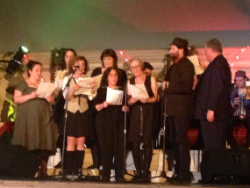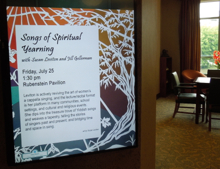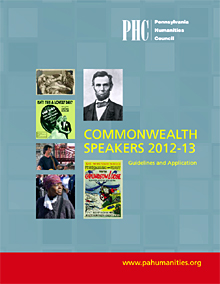CalligraphiCow Detail
What seemed like acres of space to fill on an 8-foot long fiberglass cow turned out to be a months-long project full of color and delight. This close-up of one part of her flank shows a sampling of the lettering styles I was able to explore: medieval manuscript decoration, Celtic, Fraktur, Italic, Batarde… She was a most patient cow, indeed, as I painted away!
Read MoreCalligraphiCow
In 2004, Harrisburg, Pennsylvania hosted the Cow Parade and I was one of the artists selected to prepare a cow! As an homage to the animal who continues to advance the lettering arts by providing parchment, I decided to cover her with illuminated letters from a wide range of English lettering styles from Fractur to Versal. For several winter months I painted and learned more about cow anatomy than I had ever imagined I would! I even called my husband in one day to help with a custom I’d heard about from kids called, “cow tipping” when it was time to paint her underbelly! My cow was one of the few chosen for auction, and she was purchased and donated to the city. She summers in a park near Harrisburg’s AA baseball stadium and winters over with a small herd in the train station. She’s something of the Velveteen Rabbit of the Cow Parade as she’s the only one who is constantly climbed and scribbled upon by young children. In keeping with my original intention, she has become a palimpsest with new writing constantly appearing in the form of graffiti. I do believe she is...
Read MorePrimary Donor Wall – The Residence, Harrisburg, PA
The central roundel of this wall is a brass-colored vinyl cut out backed by marble and mounted on wood. From the outside working towards center it is composed of the Biblical Seven Species, a geometric design based on the papercuts of early 20th Century artist Boruch Tzvi Ring, and a star design similar to one in a 200-year-old chased metal bowl from Damascus. All the imagery reinforces the concept of the continuity of life and Jewish spirit. Parts of the image have been reproduced throughout the independent living center on other signage. (Fabricated by Welch Architectural Signage) When designing for a public space, the artwork must not only be pleasing and invite exploration, but it must be fabricated to be low maintenance and have great longevity. For donor recognition purposes, it must also fit the culture of the institution, the setting in which it will be installed, and it should compel people to become donors and have their names added to the wall....
Read MoreSchwab Holocaust Reading Room Glass Door
The Chancellor of the Penn State Capitol Campus commissioned me to design glass doors for the newly established Schwab Family Holocaust Center housed within the library. My charge was to develop a design that would encourage people who know nothing of the Holocaust to enter and discover. She did not want a representative set of imagery, but rather an abstraction. The resulting design, set in glass ‘tells a story’ from the rich and intertwined roots of trees, through their constriction and mutilation to a full canopy bursting through an abstracted ash cloud into fresh air. The leaf canopy is built up of individually designed leaves, no two the same, and the canopy forms a mirror image of the fullness of the root ball at the very bottom. Part of my work was to interact with the architect and the glass fabricator to choose a method of transferring my design in a manner that would lose none of the fine detail and would remain maintenance-free and meet safety standards of a public...
Read MoreSecondary Donor Wall, Abramson Center
The connection to tradition in this series of very clean and contemporary wall plaques is the use of imagery and a visual style that hearkens back to heritage. The seven species, of course, is a recognizable image from Torah, and the use of a style reminiscent of Eastern European papercutting carries the tradition, unbroken into the present. How amazing it is that we live in a time when laser cutters can produce long-lasting and low maintenance public art that connects us directly to generations of Jewish artists who came before us?
Read MoreSecondary Donor Wall, The Jewish Home, Harrisburg
The purpose of this donor wall is just what it says at the top – to honor heritage and build the future. When the facility was totally renovated, this wall became necessary as a way of carrying the names of former donors into the future while encouraging new gifts. The oval panel at the top is a watercolor painting of the seven species, echoing the theme of the main donor wall and creating visual interest on a wall that is otherwise without vibrant color. Commissioned work like this requires an ability to collaborate with architects and designers to produce a ‘look’ that fits the space and serves a purpose....
Read More




























































